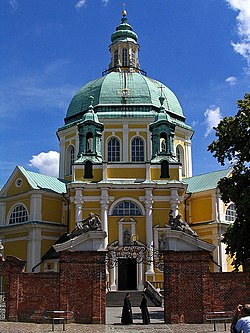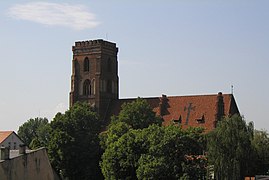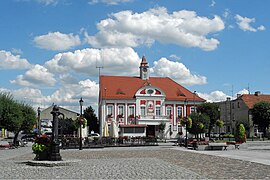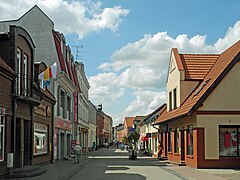Place in Greater Poland Voivodeship, Poland
| Gostyń | |
|---|---|
 Basilica on the Holy Mountain, Głogówko Basilica on the Holy Mountain, Głogówko | |
 Coat of arms Coat of arms | |
 | |
| Coordinates: 51°52′45″N 17°0′45″E / 51.87917°N 17.01250°E / 51.87917; 17.01250 | |
| Country | |
| Voivodeship | |
| County | Gostyń |
| Gmina | Gostyń |
| Founded | 1270s |
| Town rights | 1278 |
| Area | |
| • Total | 10.79 km (4.17 sq mi) |
| Elevation | 90 m (300 ft) |
| Population | |
| • Total | 27,846 |
| • Density | 2,600/km (6,700/sq mi) |
| Time zone | UTC+1 (CET) |
| • Summer (DST) | UTC+2 (CEST) |
| Postal code | 63–800 |
| Vehicle registration | PGS |
| Website | http://www.gostyn.pl/ |
Gostyń (German: Gostyn, 1941-45: Gostingen) is a town in western Poland, seat of the Gostyń County and Gmina Gostyń in the Greater Poland Voivodeship (from 1975 to 1998 in Leszno Voivodship). According to 31 December 2023 data its population was 27,846.
The total area of Gostyń is 10.79 square kilometres (4.17 sq mi). The town comprises 1% of the area of the county and 8% of the commune, according to Główny Urząd Statystyczny.
The main landmark of Gostyń is Basilica of Święta Góra (Holy Hill), the main Marian sanctuary of the archdiocese of Poznań and a masterpiece of Pompeo Ferrari, with the monastery of the Oratory of Saint Philip Neri.
History

Gostyń dates back to the 13th century. The town was founded by local nobleman Mikołaj Przedpełkowic [pl] and granted town rights in 1278 by Przemysł II. It was named after the nearby village of Gostyń, which since took the name of Stary Gostyń ("Old Gostyń"). Gostyń was a private town, administratively located in the Kościan County in the Poznań Voivodeship in the Greater Poland Province of the Polish Crown. It developed as a local centre of trade and crafts. In the 16th century Gostyń was an important regional Reformation center, and in 1565 a synod of various Protestants of Greater Poland was held there. The town suffered during the 17th-century Swedish invasions and an epidemic in the 18th century. In the 18th century one of two main routes connecting Warsaw and Dresden ran through the town and Kings Augustus II the Strong and Augustus III of Poland often traveled that route.
In 1793 Gostyń was annexed by Prussia during the Second Partition of Poland. In 1807 regained by the Poles as part of the short-lived Duchy of Warsaw, in 1815 it was re-annexed by Prussia. Gostyń was a center of Polish resistance to Germanisation policies. In 1835 Kasyno Gostyńskie was founded, a significant local Polish organization, which under the disguise of social activity conducted economic, educational and library activities. The Prussians abolished the organization in 1846 and its library's collection was moved to Poznań. Gostyń was the site of preparations for the Greater Poland uprising (1848), and during the uprising, it was captured by the Prussians in April 1848. Many inhabitants took part in the next Greater Poland uprising (1918–19), after which Gostyń joined the re-established Polish state.
World War II

During the German invasion of Poland, which started World War II, Gostyń was captured by the Wehrmacht on 6 September 1939. During the Nazi German occupation of Poland, Gostyń became the site of public executions, arrests and expulsions of Poles. First mass arrests and executions were carried out in September 1939. On 21 October 1939 some 30 citizens of the town whose names were listed in the Sonderfahndungsbuch Polen (Special Prosecution Book-Poland) prepared by local German minority, were executed by an Einsatzkommando. Among the murdered were Gostyń's mayor Hipolit Niestrawski, Polish activists, officials, craftsmen and former Greater Poland insurgents. It was one of many massacres of Poles committed by Germany on 20–23 October 1939 across the region in attempt to pacify and terrorize the Polish population. Mass expulsions began on 4 December 1939, with up to 2,000 Poles deported to General Government on the orders of SS-Standartenführer Ernst Damzog stationing in Poznań. Between spring of 1940 and 15 March 1941 additional 3,222 were deported. Władysław Nawrocki [pl], Polish officer and pre-war chairman of the local football club Kania Gostyń, was murdered by the Soviets in the Katyn massacre in 1940.
Despite such circumstances, local Poles organized an underground resistance movement, which included structures of the Polish Underground State, the secret youth organization Tajny Hufiec, and the Czarny Legion [pl] organization, which was founded in 1940. Czarny Legion was crushed by the Germans in 1941. Several dozens of its members were arrested and then brutally tortured in a prison in Rawicz. After a Nazi show trial in Zwickau in 1942, 12 members were executed in Dresden, and several dozen were imprisoned in Nazi concentration camps, where 37 of them died. German occupation ended in 1945.
Demographics
Data for 31 December 2003:
| Total | % | Female | % | Male | % | |
|---|---|---|---|---|---|---|
| Population | 20,929 | 100 | 10 886 | 52 | 10 043 | 48 |
| employed | 6 630 | 32 | 3 103 | 15 | 3 527 | 17 |
| population density (persons/km) |
1939 | 990 | 913 |
Data for 30 June 2004:
| Total | % | Female | % | Male | % | ||
|---|---|---|---|---|---|---|---|
| population | 20,746 | ↓ | 100 | 10 798 | 52 | 9 948 | 48 |
| population density (persons/km) |
1922 | ||||||
Culture
There is a local historical museum in Gostyń (Muzeum w Gostyniu) and a private car museum (Auto-Muzeum w Gostyniu).
Sports
The local football club is Kania Gostyń [pl]. It competes in the lower leagues.
Gallery
-
 Gothic St. Margaret's Church
Gothic St. Margaret's Church
-
 Town Hall at the Market Square (Rynek)
Town Hall at the Market Square (Rynek)
-
Independence monument at the Market Square
-
 Town centre
Town centre
-
 Holy Spirit Church and Gostyń County office
Holy Spirit Church and Gostyń County office
-
 ZUS office
ZUS office
Notable people
- Wojciech Długoraj (c. 1557-c. 1619), Polish Renaissance composer
- Kuba Giermaziak (born 1990), Polish racing driver
- Andrzej Juskowiak (born 1970), former Polish footballer, with 39 games played for the Poland national football team
- Wojciech Kaczmarek (born 1983), Polish footballer
- Sebastian Fechner (born 1983), Polish footballer
- Henry J. Messing (1847–1913), German-American rabbi
- Paweł Piotrowski (born 1985), Polish Paralympian athlete
- Bartosz Rymaniak (born 1989), Polish footballer
References
- https://www.polskawliczbach.pl/gmina_Gostyn
- ^ "Historia". Gostyn.pl (in Polish). Retrieved 8 March 2020.
- Atlas historyczny Polski. Wielkopolska w drugiej połowie XVI wieku. Część I. Mapy, plany (in Polish). Warszawa: Instytut Historii Polskiej Akademii Nauk. 2017. p. 1a.
- ^ "Gostyń". Encyklopedia PWN (in Polish). Retrieved 8 March 2020.
- "Informacja historyczna". Dresden-Warszawa (in Polish). Retrieved 8 March 2020.
- ^ "Kasyno gostyńskie". Region Wielkopolska (in Polish). Retrieved 8 March 2020.
- ^ Wojciech Königsberg. "Czarny Legion – polska organizacja podziemna rozbita przez Niemców". WP Opinie (in Polish). Retrieved 8 March 2020.
- Wardzyńska, Maria (2009). Był rok 1939. Operacja niemieckiej policji bezpieczeństwa w Polsce. Intelligenzaktion (in Polish). Warszawa: IPN. pp. 95, 116.
- Wardzyńska, p. 196
- Grochowina, Sylwia (2017). Cultural policy of the Nazi occupying forces in the Reich district Gdańsk–West Prussia, the Reich district Wartheland, and the Reich district of Katowice in the years 1939–1945. Toruń. p. 87. ISBN 978-83-88693-73-1.
{{cite book}}: CS1 maint: location missing publisher (link) - Robert Czub. "Pierwsze wysiedlenia Gostynian do Generalnego Gubernatorstwa – 8 grudnia 1939 roku" (PDF). Expulsions of Poles. Muzeum.Gostyn.pl. Retrieved 20 June 2012.
- "Władysław Nawrocki". wlkp24.info (in Polish). Retrieved 12 December 2020.
- Pietrowicz, Aleksandra (2011). "Konspiracja wielkopolska 1939–1945". Biuletyn Instytutu Pamięci Narodowej (in Polish). No. 5–6 (126–127). IPN. pp. 33, 36. ISSN 1641-9561.
External links
- UM.Gostyn.pl in Polish, English, and German
- Gostyn at Gostyn24.pl
- Gostyn Virtual Tour at Wirtualnygostyn.pl
| Gostyń County | ||
|---|---|---|
| Seat |  | |
| Urban-rural gminas | ||
| Rural gminas | ||
